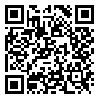1- PhD Student, Department of Curriculum planning, Isf. C., Islamic Azad University, Isfahan, Iran
2- Associate Professor, Department of Educational Sciences, Isf. C., Islamic Azad University, Isfahan, Iran ,saadatmand@iau.ac.ir
3- Associate Professor, Department of Educational Psychology, Faculty of Humanities, Dhi Qar University, Iraq
4- Assistant Professor, Department of Educational Sciences, Isf. C., Islamic Azad University, Isfahan, Iran
2- Associate Professor, Department of Educational Sciences, Isf. C., Islamic Azad University, Isfahan, Iran ,
3- Associate Professor, Department of Educational Psychology, Faculty of Humanities, Dhi Qar University, Iraq
4- Assistant Professor, Department of Educational Sciences, Isf. C., Islamic Azad University, Isfahan, Iran
Abstract: (18 Views)
Objective: The primary objective of this investigation was to critically examine and substantiate the notion of smartification within the context of Iraqi elementary school students.
Methods: The methodological framework employed was a mixed-method approach, encompassing a qualitative dimension rooted in the synthesis research model as delineated by Klein, alongside a quantitative dimension involving validation through consultations with domain experts in curriculum planning and media as well as information management. The field focus of the synthesis study aimed to elucidate the concept of smartification, utilizing reference texts that delineate the analysis of this concept. The sampling technique adopted in the synthesis study was purposive. Data analysis was conducted qualitatively through the synthesis study methodology, while the quantitative analysis was performed utilizing the Lawshe coefficient (Content Validity Ratio).
Results: The analysis of the survey responses indicated that the management system encompasses various domains including the administration of school affairs, management of educational resources, human resource management, financial resource oversight, equipment management, technological infrastructure, and security measures; the teaching and learning environment is intricately linked to the curriculum, educational content, pedagogical approaches, educational materials and equipment, as well as evaluation and implementation factors; empowerment is associated with the development of student competencies, teacher capabilities, staff qualifications, managerial skills, and professional development courses; hardware is connected to essential equipment, peripheral devices, communication technologies, and resource centers; while software pertains to content management systems, communication applications, educational software, administrative software, and security and support systems.
Conclusions: The outcomes of this research may serve as a foundation for the conceptualization of smart learning environments within Iraqi educational institutions.
Methods: The methodological framework employed was a mixed-method approach, encompassing a qualitative dimension rooted in the synthesis research model as delineated by Klein, alongside a quantitative dimension involving validation through consultations with domain experts in curriculum planning and media as well as information management. The field focus of the synthesis study aimed to elucidate the concept of smartification, utilizing reference texts that delineate the analysis of this concept. The sampling technique adopted in the synthesis study was purposive. Data analysis was conducted qualitatively through the synthesis study methodology, while the quantitative analysis was performed utilizing the Lawshe coefficient (Content Validity Ratio).
Results: The analysis of the survey responses indicated that the management system encompasses various domains including the administration of school affairs, management of educational resources, human resource management, financial resource oversight, equipment management, technological infrastructure, and security measures; the teaching and learning environment is intricately linked to the curriculum, educational content, pedagogical approaches, educational materials and equipment, as well as evaluation and implementation factors; empowerment is associated with the development of student competencies, teacher capabilities, staff qualifications, managerial skills, and professional development courses; hardware is connected to essential equipment, peripheral devices, communication technologies, and resource centers; while software pertains to content management systems, communication applications, educational software, administrative software, and security and support systems.
Conclusions: The outcomes of this research may serve as a foundation for the conceptualization of smart learning environments within Iraqi educational institutions.
Send email to the article author
| Rights and permissions | |
 |
This work is licensed under the Creative Commons - Attribution 4.0 International. |






